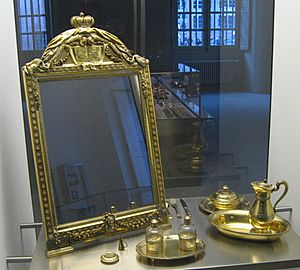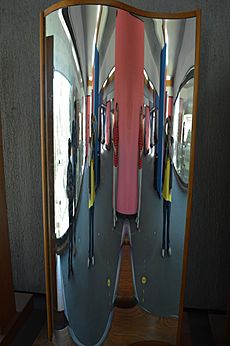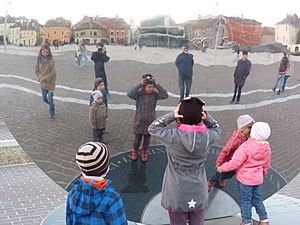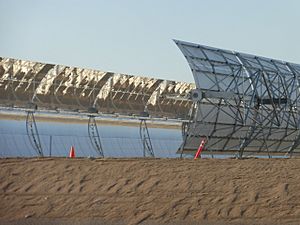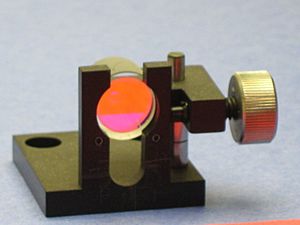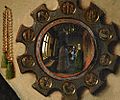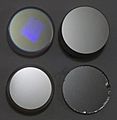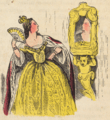Mirror facts for kids
A mirror is a special surface that reflects light. When you look into a mirror, you see a reflection of yourself or things behind you. This happens because light bounces off the mirror and into your eyes.
Sometimes, a flat piece of metal or even the surface of water can act like a mirror.
Mirrors can make things look bigger or smaller than they really are. Some mirrors curve inward (called concave), and others curve outward (called convex). These curves change how the light reflects, making images look different.
Also, if you hold writing up to a mirror, it will appear backwards. This is called a "mirror image."
Most mirrors are made from glass with a thin layer of metal on the back. This metal layer is often called "silvering," even if it's not actually silver. Some mirrors are made entirely of polished metal, which makes them stronger and less likely to break.
Contents
Different Kinds of Glass Mirrors
There are many types of glass mirrors, each made in a different way and reflecting light uniquely.
An aluminum glass mirror is made by putting a very thin layer of aluminum onto flat glass in a special vacuum chamber. Then, two or more layers of waterproof paint are added to protect it.
A low aluminum glass mirror is made with silver and two layers of protective paint. This type of mirror is very clear and reflects true, natural colors. It's often used for displaying art where exact colors are important.
A safety glass mirror has a special protective film stuck to its back. If the mirror breaks, this film holds the pieces together, preventing injuries. These mirrors are used in furniture, doors, and public places.
A silkscreen printed glass mirror has patterns printed onto the glass using special colored ink and a screen. You can find these mirrors in many colors and shapes. They are very strong and can last a long time, often used for decoration on tables, doors, and windows.
A silver glass mirror is a common type of mirror. It has a layer of silver, a copper film, and waterproof paint on the back of the glass. This makes it strong against acid and moisture. Silver glass mirrors show clear, real images and are often used in bathrooms and for furniture.
Some decorative glass mirrors are made by hand, coming in various shades, shapes, and thicknesses.
How Mirrors Change What We See
When light hits a mirror, it bounces off at the same angle it hit. Imagine a ball bouncing off a wall: it bounces off at the same angle it came in. Light does the same thing with a mirror.
- A flat mirror (also called a plane mirror) reflects light straight back. The images you see in a flat mirror look the same size as the real object.
- A concave mirror curves inward, like the inside of a spoon. It makes parallel light rays come together at a point. These are also called converging mirrors.
- A convex mirror curves outward, like the back of a spoon. It makes parallel light rays spread out.
Mirror Images and How They Appear
When you look in a flat mirror, your image seems to be flipped left-to-right. For example, if you raise your right hand, your reflection's left hand appears to go up. However, the mirror doesn't flip you upside down; your head is still above your body.
What a mirror actually does is reverse things in the direction that is straight out from its surface. Because we usually stand facing a mirror, it seems to flip our front and back. This "front-back" flip makes it look like our left and right sides have swapped.
Think of it this way: if you hold a piece of paper with text up to a mirror, the text looks backwards. This is because you are seeing the text from the "back" side, which is what the mirror shows you.
Everyday Uses for Mirrors
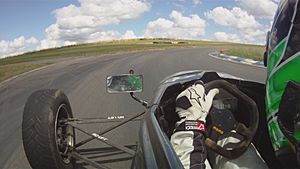
Personal Care and Grooming
Mirrors are often used to help us get ready. They come in many sizes, from small ones you can carry to large ones that show your whole body. Some mirrors can be held, while others are fixed or can be tilted, like a cheval glass.
Safety and Better Viewing
- Convex mirrors give you a wider view than flat mirrors. They are often used on vehicles, especially large trucks, to help drivers see more and reduce blind spots. You might also see them at road junctions or in parking lots to help people see around corners and avoid accidents. They can also be part of security systems to show more than one angle at a time.
- Mouth mirrors (or "dental mirrors") are used by dentists to see inside your mouth and light up areas that are hard to reach. Mechanics also use them to see into tight spaces in machines.
- Rear-view mirrors are common in cars and on bicycles. They let drivers see other vehicles coming up behind them.
One-Way Mirrors
One-way mirrors (also called two-way mirrors) seem to let you see through them from one side, but only show a reflection from the other. They work by having one side much brighter than the other. If the "viewing" side is dark and the "observed" side is bright, you can see through. But from the bright side, it just looks like a regular mirror. A true one-way mirror that only lets light go in one direction isn't possible without using energy.
Sending Signals
Mirrors can be used to send signals using sunlight. By changing the mirror's angle, you can flash signals over long distances, sometimes up to 60 kilometers (about 37 miles) on a clear day. Native American tribes and armies used this method to share information between distant places.
Mirrors are also found in survival kits. They can be used to attract the attention of search and rescue helicopters.
Mirrors in Technology
Televisions and Projectors
Tiny mirrors are a key part of many large high-definition televisions and video projectors. One common technology is called DLP. A DLP chip has millions of tiny mirrors on its surface. Each mirror can tilt to either reflect light towards the screen (making a pixel bright) or away from it (making a pixel dark).
Other projection technologies also use mirrors, like LCoS. These use a single mirror covered by a liquid crystal layer that controls which parts reflect light.
Large mirrors are also used in rear projection televisions. They "fold" the light inside the TV to make the set smaller.
Solar Power
Mirrors are very important in solar power plants. The picture shows mirrors shaped like parabolic troughs that collect sunlight to create energy.
Scientific Instruments
Telescopes and other precise instruments use front-silvered mirrors. This means the reflective surface is on the very front of the glass, which gives a clearer reflection. These mirrors often use aluminum, which reflects light well, especially at short wavelengths.
These special coatings can be easily damaged and need careful handling. They reflect most of the light that hits them (90% to 95%). A protective layer is usually added to stop the coating from corroding when it's exposed to air.
The way a mirror coating reflects light can be measured. This helps create special mirrors like cold mirrors and hot mirrors. A cold mirror lets infrared light pass through but reflects visible light. A hot mirror does the opposite, reflecting infrared light and letting visible light pass through.
For scientific work, dielectric mirrors are often used. These mirrors have many layers of special materials deposited on glass. By choosing the right materials and thicknesses, scientists can control exactly which colors and how much light the mirror reflects. The best ones can reflect more than 99.999% of light in a specific range of colors. These are often used in lasers.
In astronomy, adaptive optics use special bendable mirrors to correct blurry images caused by Earth's atmosphere. These mirrors can change shape very quickly to make stars look clearer.
While most mirrors reflect visible light, surfaces that reflect other types of waves are also called "mirrors." For example, radio telescopes use large "mirrors" to collect radio waves from space.
Images for kids
-
A 4.5-meter (15-foot) high acoustic mirror near Kilnsea, UK, from World War I. It made the sound of approaching enemy Zeppelins louder for a microphone.
-
A detail of the convex mirror from the Arnolfini Portrait painting, from 1434 AD.
-
'Adorning Oneself', a detail from an old Chinese painting, copied around the Tang dynasty (618-907 AD).
-
Polishing the main mirror for the Hubble Space Telescope. Small errors in its shape caused blurry images at first, which were later fixed.
-
The Trump International Hotel and Tower in Chicago reflects the city skyline.
-
Grove Of Mirrors by Hilary Arnold Baker in Romsey.
-
An illustration from an 1852 Icelandic translation of the Snow White fairytale.
See also
 In Spanish: Espejo para niños
In Spanish: Espejo para niños




